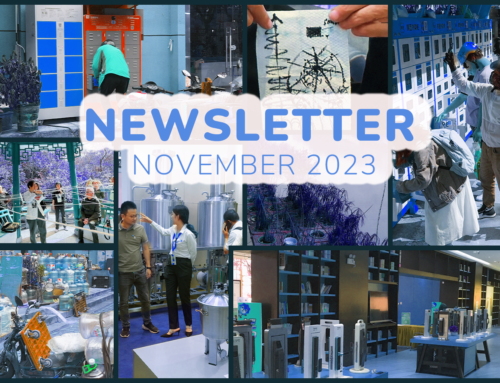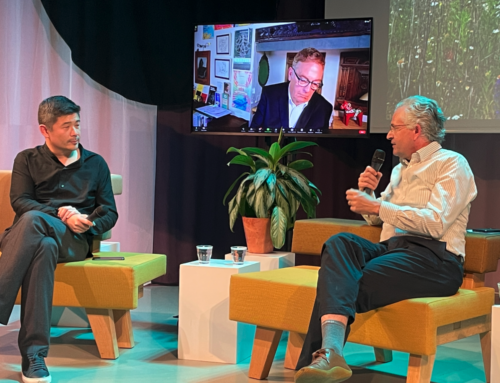Article for The Guardian (UK) in 2000 based on my CHI lecture.
What happens to society when there are hundreds of microchips for every man, woman and child on the planet? What cultural consequences follow when every object around us is ‘smart’, and connected? And what happens psychologically when you step into the garden to look at the flowers – and the flowers look at you?
You might think that such questions would preoccupy anyone involved with computers – namely, all of us. But you’d be wrong. We think about technology in the same way that a frog thinks about boiling water.
You remember the story: if you drop a frog into the pan when the water is boiling, it will leap out; but if you put the frog into a pan of cold water, and then heat it steadily towards boiling point, the frog – unaware that any dramatic change is taking place – will just sit there, and slowly cook.
Is technology cooking us?
Many hard things are certainly beginning to soften. Take products and buildings, for example, once described as ‘frozen software’: Pervasive computing begins to melt them.
Almost everything man-made, and quite a lot made by nature, will soon combine hardware and software: intelligence and connectivity are suffusing ships, aircraft, cars, bridges, tunnels, machines, refrigerators, door handles, lighting fixtures, shoes, hats, packaging.
The world is already filled with eight, twelve, or thirty computer chips for every man, woman and child on the planet. (The number depends on who you ask). Within a few years – say, the amount of time a child who is four years old today will spend in junior school – that number will rise to thousands of chips per person.
A majority of these chips will have the capacity to communicate with each other. Increasingly, many of the chips around us will sense their environment in rudimentary but effective ways. The way things are going, as writer Bruce Sterling so memorably put it, “you will look at the garden, and the garden will look at you” .
But pervasive computing is not just about flowers. Pervasive means everywhere, and that includes our bodies. Bio-mechatronics, and medical telematics, are spreading at tremendous speed. So much so, that the space where ‘human’ ends, and machine begins, is becoming blurred.
British Telecom, which spends $1 million an hour on R&D (or is a million dollars a minute, I forget) are working on an interactive corneal implant. BT are confident that by 2005 its lens will have a screen on it so video projections can be beamed straight onto your retina.
In the words of BT’s top tecchie, Sir Peter Cochrane, “you won’t even have to open your eyes to go to the office in the morning”. Thank you very much, Sir Peter, for that leap forward!
By 2010, BT expect to be making direct links to the nervous system. Links to the nervous system- – -links from it. What’s the difference? Presumably BT’s objective is that you won’teven have to wake up to go to the office…..
I call this passive acceptance of technology into our bodies Borg drift. It features a million small, specialised acts. It’s what happens when knowledge from many branches of science and design converge – without us noticing.
We are designing a world in which every object, every building, – and every body – become part of a network service, even though we did not set out to design such an outcome.
I am no Canute: railing against technology, per se, is pointless. But we do need to reflect on the bigger picture if we are to have any influence over what it looks like. This is why, to provoke a discussion inside the industry, I recently circulated some “Articles of Association Between Design, Technology and The People Formerly Known As Users”.
They go like this:
Article 1
We cherish the fact that people are innately curious, playful, and creative. We therefore suspect that technology is not going to go away: it’s too much fun.
Article 2
We will deliver value to people – not deliver people to systems. We will give priority to human agency, and will not treat humans as a ‘factor’ in some bigger picture.
Article 3
We will not presume to design your experiences for you – but we will do so with you, if asked.
Article 4
We do not believe in ‘idiot-proof’ technology – because we are not idiots, and neither are you. We will use language with care, and will search for less patronising words than ‘user’ and ‘consumer’
Article 5
We will focus on services, not on things. We will not flood the world with pointless devices.
Article 6
We believe that ‘content’ is something you do – not something you are given.
Article 7
We will consider material end energy flows in all the systems we design, and we will think about the consequences of technology before we act, not after.
Article 8
We will not pretend things are simple, when they are complex. We value the fact that by acting inside a system, you will probably improve it.
Article 9
We believe that place matters, and we will look after it.
Article 10
We believe that speed and time matter, too – but that sometimes you need more, and sometimes you need less. We will not fill up all time with content.



